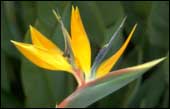Plant Profile: Bird of Paradise Botanical Name: Strelitzia reginae Family: Strelitiziacaeae Type: Perennial Size: 1.2 metres
high The Bird of Paradise owes its name to its flowers, which look just like tropical birds perched among its leaves. Though hard to grow, the exotic flowers in bloom make the effort worthwhile. Originating from South Africa, the Bird of Paradise is hardy enough to withstand a variety of weather and soil conditions, although in colder places the flowers may be damaged by heavy frosts. They flower mostly in winter and spring but if grown inside will often flower spasmodically throughout the year. Its flowers are orange or yellow in colour with dark blue tongues emerging from green boat-shaped bracts. They have no scent. The Bird of Paradise is slow-growing and can take up to ten years to grow into a clump about 1.2m high. It will also take several years before it begins to flower. These plants don't take well to being uprooted, but are usually quite happy in a large pot, making them portable. The flowers can by cut and make exquisite and unusual floral arrangements. They will last three or more weeks in a vase and are best picked when only partially open. Make a diagonal cut at the base of the stem to allow them to take up lots of water. Other varieties of
strelitzia include: Growing Care
|
Home | Journal
| Newsletter | Conferences
Awards | Join
RNZIH | RNZIH Directory | Links
© 2000–2025 Royal New Zealand Institute of Horticulture
Last updated: June 2, 2004


